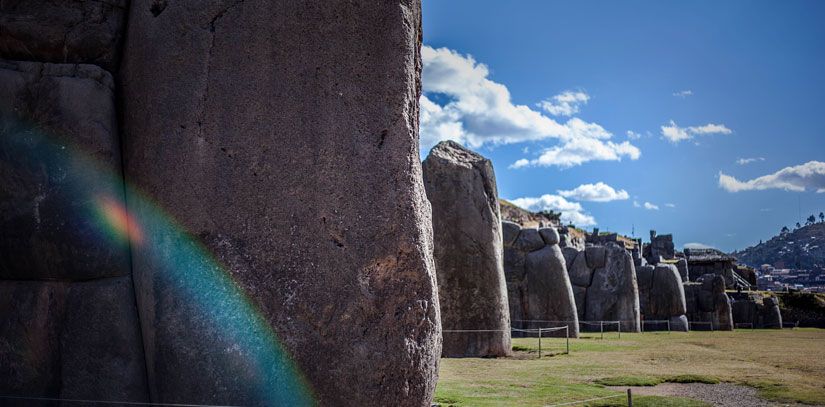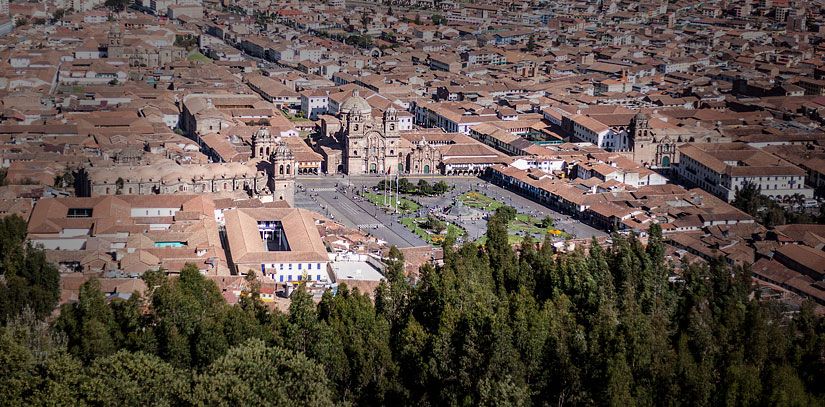
Palacio del Inka
Plazoleta Santo Domingo 259, Historic Center, Cusco
 9.4 |Exceptional
9.4 |Exceptional 5 |Excellent
5 |Excellent

Cusco is an enchanting introduction to the Andean culture and the jumping-off point for both Machu Picchu and the Sacred Valley. Browse our complete travel guide below for essential facts, travel tips, and top attractions to explore on your trip to Cusco.
Once the capital of the mighty Inca Empire, Cusco (also spelled Cuzco) holds a unique charm that's hard to put into words. Exquisite churches, fantastic museums, and narrow cobbled streets in the historic center merit at least a few days’ worth of exploration. Add to that stunning Inca ruins both within the city and in the surrounding hills and you’ve got a recipe for travel magic.
Cultural festivals throughout the year, including Señor de los Temblores and Inti Raymi, highlight the region’s mixed Spanish-indigenous heritage and illustrate the continual renewal of the community’s long-held Andean traditions. This fascinating and historically-rich city is sure to be one of the most memorable places you’ve ever set foot in.
The highland climate of Cusco has a rainy season and dry season with gradual weather and temperature changes in between. The mountainous geography of the Cusco region has a wide variety of microclimates, with drastic temperature differences between the warm and humid valleys and the frosty high altitude plains. Generally, as elevations climb higher, temperatures drop.
Rainy Season
The rainy season in Cusco is from December to March and coincides with summer in South America. Rainstorms are unpredictable, though heavy rains are usually brief and episodic. January and February typically receive the most rainfall. Cloudy skies are typical throughout the rainy season, but patchy sunshine comes through on some days. Average temperatures are around 60°F (16°C) in the day and 46°F (8°C) at night.
Dry Season
The dry season is from June to August when it's winter in South America. During these months in Cusco, it's typically beautiful and sunny. The average daytime temperature is around 65°F (18°C), but if you're in direct sunlight it can feel a lot hotter. At night, without cloud cover to create an insulation effect, the temperature dips down to a chilly 25°F (4°C).
There are benefits to visiting Cusco during each season, as well as some drawbacks.

The city of Cusco represents the sum of hundreds of years of indigenous and cultural fusion throughout the southern Andes of Peru. Excavations in the Cusco basin have uncovered artifacts and temples from the ancient Killke Culture dating as far back as 900 AD.

The Inca civilization began to develop as a city-state in 1200 AD, first co-existing with and then gradually absorbing neighboring ethnic groups. Inca oral traditions recorded after the Spanish conquest remember Manco Capac as the first Inca king.
Expansion of the Inca Empire did not begin until 1438, under the reign of Pachacutec-Cusi Yupanqui, whose name means "earth-shaker." The Inca called their lands Tawantinsuyu, which spread over much of South America and used their imperial capital of Cusco to impose political, religious, and administrative control.
The rectilinear layout of Cusco's streets is an Incan legacy. Pachacutec ordered the city rebuilt in the shape of a puma. The rivers Saphi and Tullumayo were canalized to control flooding and formed the outlines of the puma's body (the rivers continue to run underground), its loins centered on Qorikancha, and its head represented by Sacsayhuaman. This area of Cusco was reserved for the elite: the king and his lineage, priests, noble families, and their retinues. Separate areas were designated for agriculture, artisanry, and industry.

Francisco Pizarro and Spanish soldiers landed on the shores of the Inca Empire in 1531, thus marking the beginning of the end for the Inca. For a captivating re-telling of the Conquest and collapse of the Inca Empire, we suggest reading The Last Days of the Incas written by our Peru Specialist Kim Macquarrie.
In the years after the fall of the Inca Empire in 1533, the Spanish took control of Cusco. Many Inca palaces and temples were toppled completely, and the stones were used as the building blocks of Spanish-style churches and casonas. But in some cases, the Inca walls were kept intact and incorporated into the new buildings. Santa Clara Monastery, the Archbishop's Palace, and Palacio Nazarenas (formerly a convent, now a 5-star hotel) are examples of buildings with long sections of Inca walls that are on display to admire today.
Traveling to Peru in the peak season (June, July, August) requires a lot of planning several months in advance. This includes booking hotels in Cusco and Aguas Calientes (Machu Picchu), flights to/from Cusco, train tickets to/from Machu Picchu, Huayna Picchu tickets (limited to 400 and sell out weeks in advance) and Inca Trail permits if applicable.
Altitude sickness is a common health concern for travelers arriving in Cusco. Acclimation varies widely by individual, but many people adjust within 24 to 48 hours. Minor symptoms include headache, fatigue, insomnia, and loss of appetite. Severe reactions to high elevations are rare and hard to predict.
Before you travel, ask your doctor about medications to prevent altitude sickness. During your stay to Cusco, keep hydrated, avoid heavy meals, and try the local remedy, coca leaf tea. If you're planning to trek to higher elevations, plan to spend a few days acclimating in Cusco before beginning the journey.
Cusco day excursion checklist:
Dry season packing suggestions:
Rainy season packing suggestions:
The best area to stay in Cusco is in the historic downtown, which has countless restaurants, museums, Inca ruins, and other top attractions within easy walking distance. Some of the city’s most charming hotels are an uphill walk from the Plaza de Armas in the San Blas neighborhood, which might not be the best option for anyone with physical limitations or concerned about overexerting themselves in the high elevation. Cusco accommodation ranges from backpacker party hostels, AirB&B, and comfortable hotels that include complimentary breakfast. Check out our preferred places to stay in the Hotels section above.
Walking is the best way to get around the historic center of Cusco. You can stroll from one side of the historic center to the other within 15 to 20 minutes. Around the Plaza de Armas you’ll find Cusco’s top attractions, restaurants, and nightlife options. The area around the main plaza is mostly flat, but the streets become steeply inclined when you walk toward the San Blas, San Cristobal, or Santa Ana neighborhoods.




Santo Domingo Church encloses one of Cusco's most impressive Inca ruins, the Coricancha or Temple of the Sun. According to chronicles written after the Spanish conquest, it was the largest and most opulent temple in all of South America, filled with gold, silver, and precious jewels. Inca oral traditions indicate that the temple, dedicated to the worship of Inti, the sun god, was built during the reign of Manco Capac in the 12th century atop a pre-existing temple. Beginning in 1536, Santo Domingo Church was built upon the ruins of the Coricancha, but tantalizing vestiges of the former Inca temple were kept intact. The most intriguing feature is an exceptionally well-crafted semicircular wall that's visible from Avenida El Sol.

The Sacsayhuaman ruins are on a hill overlooking Cusco and rise in front of a vast esplanade the length and width of four football fields. The original Inca-built walls were 10 feet (3 meters) taller. On the topmost platform were three circular towers. The gargantuan scale of Sacsayhuaman's zigzagging, terraced walls will make your jaw drop, even more, when you realize they represent just a fraction of the original site.






The Inca Empire placed profound importance on astronomy. The observations they made in their natural environment, like those up in the sky, were deeply rooted in their spiritual beliefs and day-to-day activities. A visit to the Planetarium Cusco is an opportunity to learn about Inca constellations and the southern night sky. If the weather permits, you can observe the star-studded sky over Cusco through a telescope. The planetarium is a family-run project located in an Andean-style house with adobe walls up in the surrounding hills next to Sacsayhuaman about a 10-minute drive from the Plaza de Armas.
Note: The Cusco Tourist Ticket (or boleto turístico del Cusco) gives you access to a variety of Inca ruins and museums. The popular Full Ticket is valid for ten days and includes entry to sixteen attractions, including Sacsayhuaman, Qorikancha, the Museum of Pre-Columbian Art, and many more.
As one of Peru's most popular destinations, Cusco boasts a range of hotels for every budget. Within the historic center of the city, you'll find colonial buildings that have been restored into elegant 4- and 5-star hotels, old family houses converted into cozy guesthouses, and everything in between. The following are our Top Pick Hotels in Cusco, selected for their excellent amenities, outstanding service, and convenient location.


Plazoleta Santo Domingo 259, Historic Center, Cusco
 9.4 |Exceptional
9.4 |Exceptional 5 |Excellent
5 |Excellent
Plazoleta de Limacpampa Chico 473, Historic Center, Cusco
 9 |Wonderful
9 |Wonderful 4.6 |Excellent
4.6 |Excellent
Tocuyeros 566, San Blas, Cusco
 9.2 |Wonderful
9.2 |Wonderful 4.5 |Excellent
4.5 |Excellent
Calle San Agustin 256, Cusco
 |
| 4.5 |Excellent
4.5 |Excellent




6 days from $1339
Cusco, Sacred Valley and Machu Picchu


4 days from $1009
Cusco, Sacred Valley and Machu Picchu


9 days from $2239
Cusco, Inca Trail, Sacred Valley & Machu Picchu


6 days from $1919
Cusco, Rainbow Mountain, Machu Picchu & 2-day Inca Trail


12 days from $2639
Machu Picchu, Sacred Valley, Cusco, Amazon, Arequipa & Colca Canyon


9 days from $3759
Cusco, Sacred Valley, Machu Picchu, Lima & Amazon Cruise
Email: [email protected]
Sign up to receive our newsletter for great articles, stunning photos, and special deals.